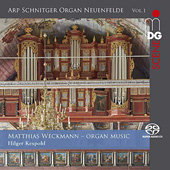
ESSENTIAL RECORDINGS

Komm, Heiliger Geist, Herre Gott
Toccata in D
Fantasia in D
Gelobet seist du, Jesu Christ
Toccata in e
Ach wir armen Sünder
Praeludium a 5 Vocum in G
Gott sei gelobet und gebenedeiet
Praeambulum primi toni a 5
Nun freut euch, lieben Christen gmein
Toccata vel praeludium primi toni
Fuga in D primi toni pedaliter
Magnificat Secundi Toni
Based on this CD's title Arp Schnitger Organ Neuenfelde Vol. 1, it's obvious that the star attraction of this recording is the instrument itself. And for good reason, as this seems to be the first commercial recording of this 1688 Baroque organ following its "successful" restoration completed in 2017. There seems to have been many botched attempts over the centuries to do this, many of which were considered bad alterations rather than restoring it to its original state, which is what the workshop of Kristian Wegscheider accomplished in 2017. Thanks to the recycling of many of its original parts, it's now considered an authentic representation of Baroque organ building, and the ideal instrument on which to play North German Baroque organ music. The church of St. Pankratius in Neuenfelde was built in 1682. According to the booklet notes: the congregation still owed money on the organ in 1693, five years after its completion, and apparently settled the debt by allowing Arp Schnitger to build his own 'personal' church pew close to the pulpit, and granting him the rights to burial within the church. He was buried there in 1719. These days the church would most likely be issued a lawsuit for non-payment and dragged to court. How society has changed ....
Now let's not forget about Matthias Weckmann (1616-1674). Apart from some of his organ pieces scattered across multiple collections of organ music by various composers, only a handful of recordings are devoted solely to his music, so it's nice to see the MDG label devote the first volume of this new series to his music. Weckmann could be seen as the link between Sweelinck and Buxtehude, which in turn greatly influenced the music of Bach. And since harmonic counterpoint was barely in its infancy at the time, his prime development tool was the use of ascending and descending scales built around the tonic and repeated in different ways. More like improvised variations on a key, rather than complex harmonic and linear buildup. Although when you listen to the 6-part verse from the Magnificat Secundi Toni you start to hear interesting harmonic shifts and combinations that hint to the fact that Bach was only a few years away.
Organist Hilger Kespohl who has been at St. Pankratius since 2007 actually played a role as an advisor in the restoration process of this Arp Schnitger organ, and nothing beats standing inside a pipe organ's case assembling pipes unto windchests to help you understand an organ's mechanics and to connect your actions on the keyboards to the sounds these pipes generate. The restored Neuenfelde organ only has about 35 stops but that doesn't prevent Hilger Kespohl from applying varied couplings and combinations throughout to avoid ear fatigue. The organ's voice is always clean and sharp, and serves this music very well.
Jean-Yves Duperron - March 2019